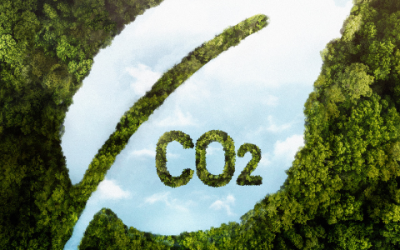Understanding the carbon impact of agri-food: from field to plate

According to government figures, food accounts for 20% of greenhouse gas (GHG) emissions in France, making it the third largest emitting sector, after transport and housing.
In theprimary food sector, every decision, every process and every partnership has a significant impact on the environment. Companies operating in this sector, from ingredient suppliers to foodservice providers, are both major players and responsible stakeholders in the food production chain.
However, measuring this footprint, from field to distribution to consumption, is no simple matter. It is imperative to transform this complexity into an opportunity for agri-food businesses.
Find out how companies in this sector can not only contribute to a more sustainable future, but also strengthen their market position by proactively responding to the changing expectations of customers and stakeholders.
1. Carbon footprint in the food industry
1.1. The main greenhouse gases
1.2. Specific sources of emissions in each phase of the supply chain.
2. From field to plate: Reducing carbon impact at every stage
2.2. Food processing and distribution
3. A united supply chain for a greener agri-food industry
3.1. The importance of collaboration between all players in the supply chain.
Carbon footprint in the food industry
The carbon footprint is a measure of the greenhouse gas (GHG) emissions associated with an activity, product or process. It quantifies the contribution of a particular activity to global warming.
In the agri-food sector, the carbon footprint represents all the GHG emissions generated from the production of raw materials to their processing, transport, distribution, preparation and consumption. It covers the entire food chain, from field to plate.
Joseph Poore's 2018 study on the environmental impact of global food production found that it contributes around 26% of global emissions.
☁️ The main greenhouse gases emitted
There are 3 main greenhouse gas emissions of particular concern in the food industry: carbon dioxide (CO2), methane (CH4) and nitrous oxide (N2O).
CO2 is mainly emitted during the combustion of fossil fuels for transport, heating and electricity, but also during deforestation for agricultural expansion.
CH4 is generated by animal enteric fermentation processes, agricultural waste management and flooded rice production.
N2O comes mainly from the use of nitrogen fertilizers and agricultural practices.
🔗 S pecific sources of emissions in each phase of the supply chain
Each stage in the agri-food supply chain has its own specific sources of emissions. Here is an overview of the main sources of emissions in each phase:
🪓 A gricultural production: use of fertilizers and pesticides, enteric emissions from animals, deforestation for farmland expansion.
🍟 F ood processing: energy consumption for cooking, cooling, freezing, packaging, transport, industrial processes.
🚚 Distribution: Transport of food to points of sale, refrigeration, storage.
🍽️ Consumption: Culinary preparation, domestic refrigeration, food waste.
To produce a comprehensive carbon footprint tailored to the agri-food sector, it is essential to rely on a platform that fully understands the specificities of this industry. This is where Global Climate Initiatives comes in, a platform designed to adapt to each sector of activity. By creating your own space on GCI, you can choose a customized questionnaire designed specifically for the agri-food sector.
GCI enables you to obtain a greenhouse gas emissions report for the entire value chain, covering scopes 1, 2 and 3.
What's more, one of GCI's strengths lies in its ability to involve your suppliers in calculating your carbon footprint. The platform offers a collaborative environment, encouraging exchanges between customers and suppliers. This enables you to achieve your purchasing decarbonization objectives.
By using your suppliers' actual carbon performance data, you can refine your analyses and make more informed purchasing decisions. This positive carbon discrimination approach strengthens your company's competitiveness and prepares it for the future.
From field to plate: Reducing carbon impact at every stage
🧑🌾 Conventional agriculture
⚠️ Conventional agriculture, with its intensive use of chemical fertilizers and pesticides, has a significant carbon footprint. Greenhouse gas emissions come mainly from the production and use of nitrogen fertilizers, the energy required for farm machinery, and deforestation to expand farmland.
🌿 S ustainable agricultural practices, such as organic farming (bio), reducing the use of chemical fertilizers, effectively managing agricultural waste and planting trees for carbon sequestration, help to reduce agriculture's carbon footprint. These approaches promote a more responsible use of natural resources, reduce GHG emissions and improve soil health.
Discover the carbon footprint of a farm.
🍟 F ood processing and distribution
⚠️ Food processing, packaging, refrigeration and transportation are important stages in the agri-food supply chain. They generate CO2 emissions linked to energy consumption and emissions resulting from transport.
In particular, refrigeration and air-conditioning systems are responsible for a significant proportion of greenhouse gas emissions, notably hydrofluorocarbons (HFCs), which have a high global warming potential.
Energy efficiency and waste reduction in these processes are essential to minimize carbon impact.
🌿 S hort circuits, such as local markets and direct sales, as well as the use of local produce, reduce the distance food travels between the farm and the consumer's plate. This minimizes transport-related emissions, supports local farmers and promotes more sustainable food.
🍽️ Consumers' Food Choices
⚠️ Consumer food choices have a considerable impact on the carbon footprint of the agri-food industry. Consumption of red meat, for example, is associated with significant methane emissions, while a preference for local and seasonal foods can reduce overall carbon impact.
🌿 Raising consumer awareness of sustainability issues in food and educating them about responsible food practices are essential ways of reducing the global carbon footprint. Awareness campaigns, sustainability labels and access to transparent information on food origins and production methods are all tools to encourage more sustainable choices.
A united supply chain for a greener agri-food industry
Companies in the agri-food sector can play a key role in implementing these strategies and encouraging their partners to do the same.
🤝 The importance of collaboration between all players in the supply chain
Reducing the carbon footprint of food cannot rest solely on the shoulders of producers, processors or distributors. It's a shared responsibility that requires the collaboration of all players in the supply chain, from farmers to consumers.
The creation of sustainable partnerships and the implementation of good environmental practices throughout the chain are essential to achieving carbon reduction targets.
Food companies have a major role to play in facilitating this collaboration. They can encourage their suppliers to adopt more environmentally-friendly practices, promote sustainable development initiatives and help educate consumers about the importance of sustainable food choices.
🛒 D ecarbonizing purchasing: involving suppliers.
Decarbonizing purchasing, also known as "low-carbon purchasing", represents a commitment to practices designed to reduce the GHG emissions emitted during a company's procurement process.
This means that organizations must calculate the carbon weight of their products and services, taking into account the entire life cycle, including production, transport and disposal. The aim is to minimize this impact by choosing more environmentally sustainable products and suppliers.
Decarbonizing purchasing is an essential strategy for the food industry. It enables us to meet the challenges of reducing GHG emissions and promoting more sustainable practices throughout the supply chain.
🌍 GCI offers a complete tool for sending invitations and emission factor requests/transmissions. You can invite your suppliers to the GCI platform so that they can calculate the carbon footprint of all their products. What's more, you can transmit your own emission factors to your customers, enabling them to accurately measure their carbon impact.
The service for calculating the carbon footprint of products is available free of charge to all. Your suppliers can then calculate the emission factor of each product in their catalog.
If they wish to take a more comprehensive approach to carbon assessment, they can also do so on the GCI platform, at a cost starting at €450.
On the same subject: find out more about the energy sector's carbon footprint.







